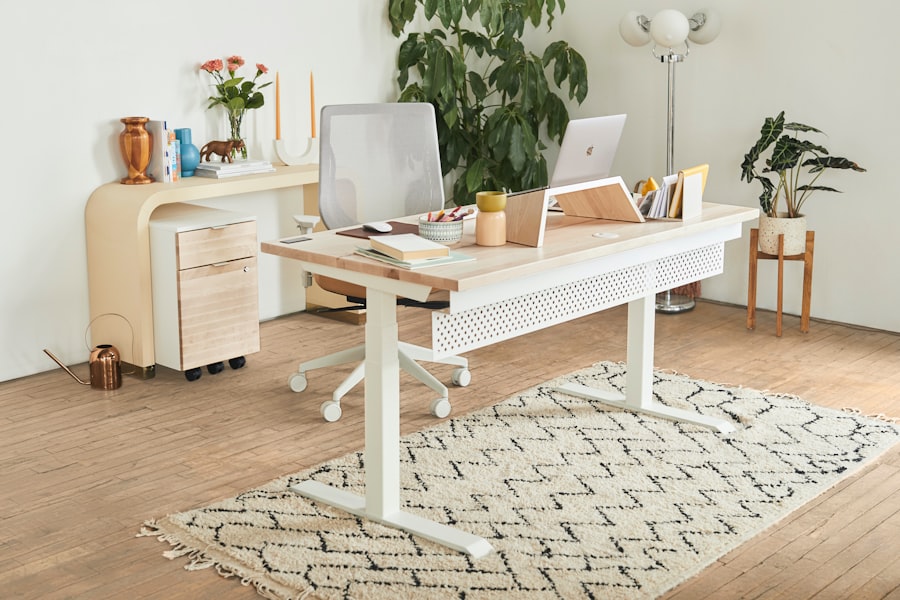In the modern workplace, the significance of ergonomic chairs cannot be overstated. These chairs are meticulously designed to support the natural curvature of the spine, promoting a healthy posture that can prevent the onset of musculoskeletal disorders. With features such as adjustable seat height, lumbar support, and armrests, ergonomic chairs cater to the diverse needs of individuals, allowing for a customized seating experience.
For instance, a chair that allows users to adjust the lumbar support can help alleviate lower back pain, which is a common complaint among office workers who spend long hours seated. Moreover, the impact of ergonomic chairs extends beyond physical comfort; they also play a crucial role in enhancing productivity. Research has shown that when employees are comfortable, they are more focused and engaged in their tasks.
A study conducted by the University of California found that workers using ergonomic chairs reported a 17% increase in productivity compared to those using standard office chairs. This increase can be attributed to reduced discomfort and fatigue, allowing employees to maintain their concentration for longer periods. Therefore, investing in high-quality ergonomic chairs is not merely a matter of comfort; it is a strategic decision that can lead to improved performance and overall job satisfaction.
Key Takeaways
- Ergonomic chairs are essential for comfort and productivity in the office.
- Adjustable desks allow for finding the right height for individual work preferences.
- Organizing office storage solutions can greatly improve efficiency and productivity.
- Task lighting is crucial for illuminating workspaces and maintaining focus.
- Meeting and collaboration furniture is important for creating spaces that encourage teamwork and creativity.
Adjustable Desks: Finding the Right Height for Your Work
Adjustable desks have emerged as a popular solution for creating a flexible work environment that accommodates various tasks and preferences. These desks allow users to switch between sitting and standing positions, promoting movement throughout the day. The ability to adjust the height of a desk is particularly beneficial for individuals who may experience discomfort from prolonged sitting.
For example, a person who spends hours typing may find relief by standing for part of their workday, which can help reduce strain on the back and neck. The versatility of adjustable desks also supports different work styles and activities. For instance, collaborative tasks may benefit from a standing arrangement where team members can easily engage with one another, while focused tasks may be better suited for a seated position.
Furthermore, studies have indicated that alternating between sitting and standing can lead to increased energy levels and improved mood. A report from the American Journal of Preventive Medicine highlighted that participants who used sit-stand desks reported less fatigue and greater overall well-being. This adaptability not only enhances individual comfort but also fosters a dynamic work environment that can lead to greater creativity and collaboration.
Storage Solutions: Organizing Your Office for Efficiency

Effective storage solutions are essential for maintaining an organized workspace that promotes efficiency and productivity. Cluttered desks can lead to distractions and hinder focus, making it crucial to implement systems that keep essential items easily accessible while minimizing chaos. Various storage options are available, including filing cabinets, shelving units, and desk organizers, each serving a unique purpose in creating an orderly environment.
For example, vertical storage solutions such as wall-mounted shelves can maximize space in smaller offices while providing easy access to frequently used materials. In addition to physical storage, digital organization is equally important in today’s technology-driven workplaces. Implementing cloud storage solutions allows employees to access files from anywhere while reducing the need for physical paperwork. This not only declutters the physical workspace but also enhances collaboration among team members who can share documents seamlessly. By combining effective physical storage with digital organization strategies, businesses can create an environment that fosters efficiency and minimizes time wasted searching for misplaced items.
Task Lighting: Illuminating Your Workspace for Focus
The role of task lighting in an office environment is often underestimated, yet it is a critical component of creating an effective workspace. Proper lighting can significantly influence mood, focus, and overall productivity. Task lighting refers to specific light sources designed to illuminate work areas without causing glare or eye strain.
Desk lamps with adjustable brightness levels allow individuals to customize their lighting based on their specific tasks, whether it be reading documents or working on intricate designs. Natural light is another vital aspect of task lighting that should not be overlooked. Studies have shown that exposure to natural light can enhance mood and energy levels while reducing eye strain.
Offices with large windows or skylights can provide ample daylight, creating a more inviting atmosphere. However, when natural light is limited, incorporating full-spectrum bulbs that mimic daylight can help maintain a bright and stimulating environment. By thoughtfully considering task lighting options, organizations can create spaces that not only enhance visibility but also contribute to employee well-being and productivity.
Meeting and Collaboration Furniture: Creating Spaces for Teamwork
The design of meeting and collaboration furniture plays a pivotal role in fostering teamwork and effective communication within organizations. Traditional conference rooms often feature large tables surrounded by rigid chairs, which may not encourage open dialogue or creative brainstorming. In contrast, modern collaborative spaces utilize flexible furniture arrangements that promote interaction and engagement among team members.
For instance, modular seating options allow groups to reconfigure their environment based on the nature of their discussions, whether they require formal presentations or casual brainstorming sessions. Additionally, incorporating technology into meeting spaces enhances collaboration by enabling seamless communication and information sharing. Conference tables equipped with built-in screens or connectivity options allow participants to share presentations or documents effortlessly.
Furthermore, mobile whiteboards or writable surfaces encourage spontaneous idea generation and visual collaboration during meetings. By investing in versatile meeting furniture that adapts to various needs, organizations can create environments that inspire creativity and strengthen team dynamics.
Technology Integration: Choosing Furniture to Support Your Devices

As technology continues to evolve at a rapid pace, integrating it into office furniture design has become increasingly important. Modern workplaces rely heavily on devices such as laptops, tablets, and smartphones, necessitating furniture that accommodates these tools effectively. Desks with built-in cable management systems help keep cords organized and prevent clutter while ensuring easy access to power outlets for charging devices.
This thoughtful integration not only enhances aesthetics but also contributes to a more functional workspace. Moreover, furniture designed specifically for technology use can enhance productivity by providing ergonomic solutions tailored to device usage. For example, monitor stands can elevate screens to eye level, reducing neck strain while improving posture during extended computer use.
Additionally, mobile charging stations allow employees to power their devices without interrupting their workflow. By prioritizing technology integration in furniture design, organizations can create environments that support modern work habits while promoting employee comfort and efficiency.
Breakroom Furniture: Designing a Relaxing Space for Recharging
The breakroom serves as a vital space within any workplace where employees can recharge and socialize during their breaks. Thoughtfully designed breakroom furniture can significantly enhance this experience by creating an inviting atmosphere conducive to relaxation and informal collaboration. Comfortable seating options such as lounge chairs or sofas encourage employees to unwind during their downtime while fostering social interactions among colleagues.
In addition to comfort, functionality is key in breakroom design. Tables that accommodate both small group discussions and larger gatherings provide flexibility for various social dynamics. Incorporating amenities such as coffee machines or snack stations further enhances the breakroom experience by offering convenient access to refreshments.
By creating a well-designed breakroom with comfortable furniture and essential amenities, organizations can promote employee well-being and satisfaction while encouraging positive workplace relationships.
Personalization and Decor: Adding a Touch of Inspiration to Your Office
Personalization in the workplace has gained recognition as an essential element in fostering employee engagement and satisfaction. Allowing individuals to customize their workspaces with personal items such as photos, artwork, or plants can create a sense of ownership and belonging within the office environment. This personal touch not only enhances individual morale but also contributes to a more vibrant workplace culture.
Incorporating decor elements that reflect the company’s values or mission can further inspire employees and create a cohesive identity within the office space. For instance, displaying artwork created by local artists or showcasing employee achievements through visual displays can instill pride among team members while reinforcing organizational goals. Additionally, integrating biophilic design principles—such as incorporating natural elements like plants or water features—can enhance well-being by connecting employees with nature.
By prioritizing personalization and thoughtful decor choices, organizations can cultivate an inspiring atmosphere that motivates employees and fosters creativity in their work.
If you are looking to upgrade your office with new meeting room furniture, you may want to check out this article on officeinterior.ae. The article discusses the importance of having comfortable and functional furniture in your meeting room to create a professional and productive environment. Additionally, if you are interested in innovative office desk designs, you can also read about it on the same website at officeinterior.ae. This article explores unique and creative desk designs that can enhance the aesthetics and functionality of your workspace. Lastly, if you want to stay updated on the latest modern office design trends, be sure to visit officeinterior.ae for valuable insights and inspiration.
FAQs
What are the essential furniture items for an office?
Essential furniture items for an office include desks, chairs, filing cabinets, bookshelves, and storage units. Other important items may include conference tables, reception desks, and ergonomic accessories.
What are the key factors to consider when choosing office furniture?
Key factors to consider when choosing office furniture include the size and layout of the office space, the comfort and functionality of the furniture, the overall aesthetic and design, as well as the budget and durability of the furniture.
What are some popular materials used for office furniture?
Popular materials used for office furniture include wood, metal, glass, and laminate. Each material has its own advantages in terms of durability, aesthetics, and cost.
How can office furniture contribute to a productive work environment?
Office furniture can contribute to a productive work environment by providing ergonomic support, creating a comfortable and organized workspace, and promoting collaboration and communication among employees.
What are some important considerations for ergonomic office furniture?
Important considerations for ergonomic office furniture include adjustable features for chairs and desks, proper support for the back and arms, and the ability to customize the furniture to fit the individual needs of employees.
What are some trends in office furniture design?
Some trends in office furniture design include the use of sustainable and eco-friendly materials, flexible and modular furniture systems, and the integration of technology into furniture pieces such as charging stations and built-in connectivity.


